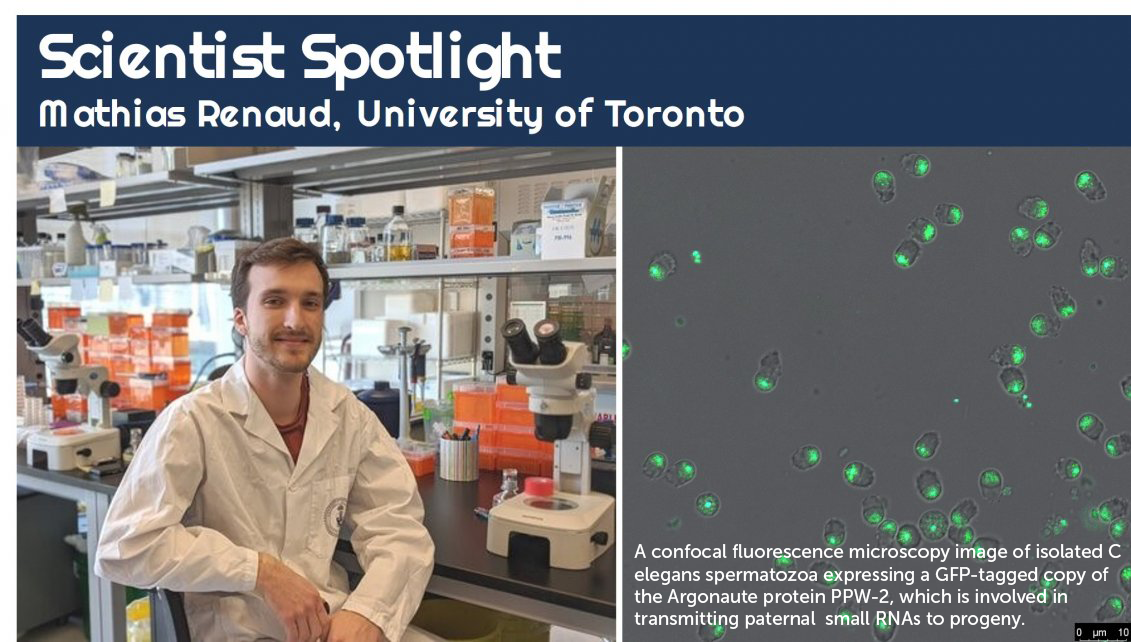Mathias Renaud is a Graduate Student in Dr. Julie Claycomb's laboratory at the University of Toronto. Learn more about Mathias and his research in this Q&A and stay tuned for his upcoming presentation at the May 2021 CEEHRC Seminar!
What are you working on?
With diverse roles in essential biological processes including development, genome stability, and fertility, small RNA (sRNA) pathways are key regulators of gene expression. sRNAs direct sequence‐specific gene regulation by associating with effector Argonaute proteins (AGOs) to either degrade, inhibit translation, or promote expression of target transcripts. With a robust developmental program and an expanded group of 19 AGOs, Caenorhabditis elegans is a superb system to study these highly conserved regulatory mechanisms. Our lab has systematically characterized the expression and sRNA populations associated with all 19 AGOs in C. elegans. In doing so, we identified four AGOs expressed in the gonad only during spermatogenesis, and nine AGOs expressed constitutively in the germline. Although it is well established that sRNA pathways are essential for fertility in multiple organisms, the bulk of worm sRNA research has focused on roles in oogenesis. Therefore, we aim to understand how these 13 AGO sRNA pathways contribute to proper sperm development and paternal epigenetic inheritance. By assessing trans‐generational fertility in single and multiple spermatogenesis‐specific ago mutants, we have observed stress-induced reductions in fertility that can be rescued by mating to wild-type males, pointing to defects in spermatogenesis. Our current efforts are focused on understanding the molecular mechanisms by which the spermatogenesis AGOs contribute to the development and differentiation of fertile sperm. Because mature spermatids can carry several potential epigenetic couriers to progeny, including chromatin modifications and sRNAs, we also aim to understand which AGOs and sRNAs are passed from father to progeny via sperm. Using our set of GFP‐tagged AGOs, we determined that only two AGOs are packaged into mature sperm, one in the nucleus and one cytoplasmically. Collectively, our work will define new pathways and gene regulatory modes that contribute to male fertility and epigenetic inheritance.
Where are you from? What do you miss about your hometown/country?
Windsor, ON. I miss the great pizza that hasn’t been matched anywhere else I’ve lived.
What city do you currently live in and what do you like most about this city?
Toronto, ON. I like how much there is to explore by walking around the city.
What are some ways you detach from work/science/academia?
Taking my dog for long walks.
Do you have a recommendation for a book, show, movie or documentary?
Book: Deep Work by Cal Newport
Show: Ted Lasso
What made you decide to become a researcher?
After some research experiences as an undergrad I couldn’t imagine myself doing anything else.
What sparked your interest in epigenetics?
As a summer undergraduate researcher at SickKids I worked on identifying disease signatures in DNA methylation patterns from patient samples. I was able to see first-hand how epigenetic research could be applied in a medical setting.
If you could give your “first-year-PhD-self” one piece advice, what would it be?
Work sustainably. Alternatively: get as much done as possible before a pandemic shuts the lab down.

